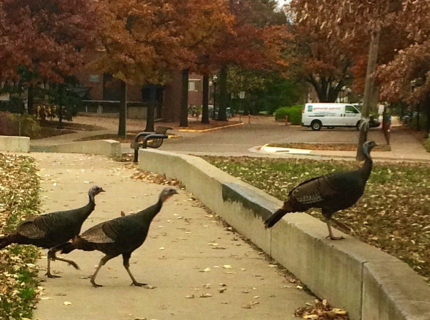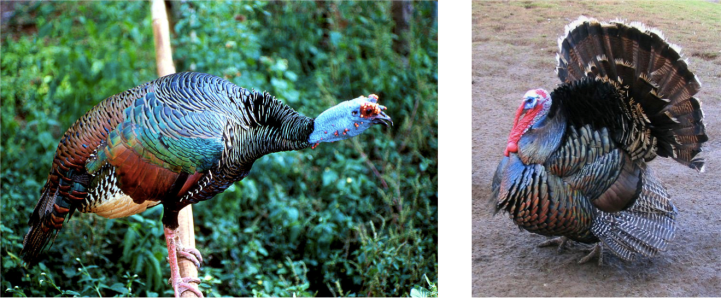Did you know that Americans consume a whopping average of 46 million turkeys at Thanksgiving? That’s about 1 turkey for every 7 Americans!1,2 With the colossal number of turkeys consumed during the holidays, it only makes sense that we often think of turkeys as just a food source.
But what if I were to tell you that turkeys could actually inspire future technologies? Is this completely unthinkable? Well, actually, no! Birds, such as turkeys, have unique iridescent feathers that researchers can potentially study to form newer and better forms of video displays, fiber optic telecommunications, and computer chips, to name a few.

So after you gobble up your Thanksgiving dinner, your next Black Friday tech splurge might also involve turkeys. Wow, now that’s a lot of thanks to give to our feathered friends!
So what is this turkey-nanotechnology connection? As it turns out, turkey plumages have little compartments that can either be hollow or contain color pigments. The compartments pack together into unique nanostructured arrangements within the feather barbules3 (see image below) to produce iridescent colors. We’ve written on the blog before about how nanoscale structures can create iridescence in butterfly wings. The iridescent phenomena with the nanostructures in turkey feathers are quite similar.

Scientists have a fancy name for these arrangements: photonic crystals. Photonic crystals are nanoscale structures that can manipulate photons (packets of incoming light waves).4-6 Simply put, these structures can allow certain wavelengths of light to pass through them while blocking others. By controlling the nanostructured arrangement of photonic crystals, scientists can control the exotic and intense colors that are emitted. Remember, our eyes perceive color based on which wavelengths of light bounce off the object we’re looking at.

Naturally occurring photonic crystals like those in turkey feathers have a variety of potential technological applications. For instance, new optical switches could be created that would permit certain wavelengths of light to travel from one computer chip to another while blocking all other wavelengths. Optical switches could be the topic for a whole other blog post,7 but suffice it to say that kind of development could potentially make it possible to transport terabytes of data per second. That’s the same as me hurling an entire computer hard drive at your face and somehow having you see all the pictures, videos, and music I’ve ever put on it within one second!
The technology of photonic crystals is still in its early stages because of the inherent difficulty in making well-controlled 3-dimensional nanoscale structured arrangements. However, photonic crystals produced in nature by animals such as turkeys are being studied with the hopes that we can perhaps mimic the way nature controls such iridescent and vibrant colors. This may bring us yet another step closer to a technological revolution.
And those, my friends, are some fun facts about turkeys that you can bring to your Thanksgiving dinner table. Happy Thanksgiving to everyone!
EDUCATIONAL RESOURCES
- Want to see more close-up images of ocellated turkey feathers? Check out here and here.
- “The Nature of Feathers” Multidisciplinary Classroom Activities: Young Naturalists article and teacher’s guide
- NISEnet activity: Colors at the Nanoscale: Butterflies, Beetles and Opals
- National Turkey Federation. Turkey History & Trivia, 2015: http://www.eatturkey.com/why-turkey/history
- U.S. Census Bureau. U.S. and World Population Clock, 2015: http://www.census.gov/popclock/
- Eliason C., Bitton P.-B., & Shawkey M. How hollow melanosomes affect iridescent colour production in birds. Proceedings of the Royal Society of London B: Biological Sciences, 2013, 280(1767), 20131505. doi: 10.1098/rspb.2013.1505
- Heuss, C. Photonic crystals may become the ‘transistor of the 21st century’, scholar predicts. Stanford Report, March 6, 2002: http://news.stanford.edu/news/2002/march6/AAASfan-36.html
- Ming X., Li Y., Allen M., Deheyn D., Yue X., Zhao J., Gianneschi, N., Shawkey M., & Dhinojwala A. Bio-Inspired Structural Colors Produced via Self-Assembly of Synthetic Melanin Nanoparticles. ACS Nano. 2015, 9 (5) 5454–5460. doi: 10.1021/acsnano.5b01298
- Sun J., Bhushan B., & Tong J. Structural coloration in nature. RSC Advances, 2013, 3(35), 14862-14889. doi: 10.1039/c3ra41096j
- Kengo N., Tanabe T., Shinya A., Matsuo S., Sato T., Taniyama H., & Notomi M. Sub-femtojoule all-optical switching using a photonic-crystal nanocavity. Nature Photonics, 2010, 4(7), 477-483. doi: 10.1038/nphoton.2010.89
